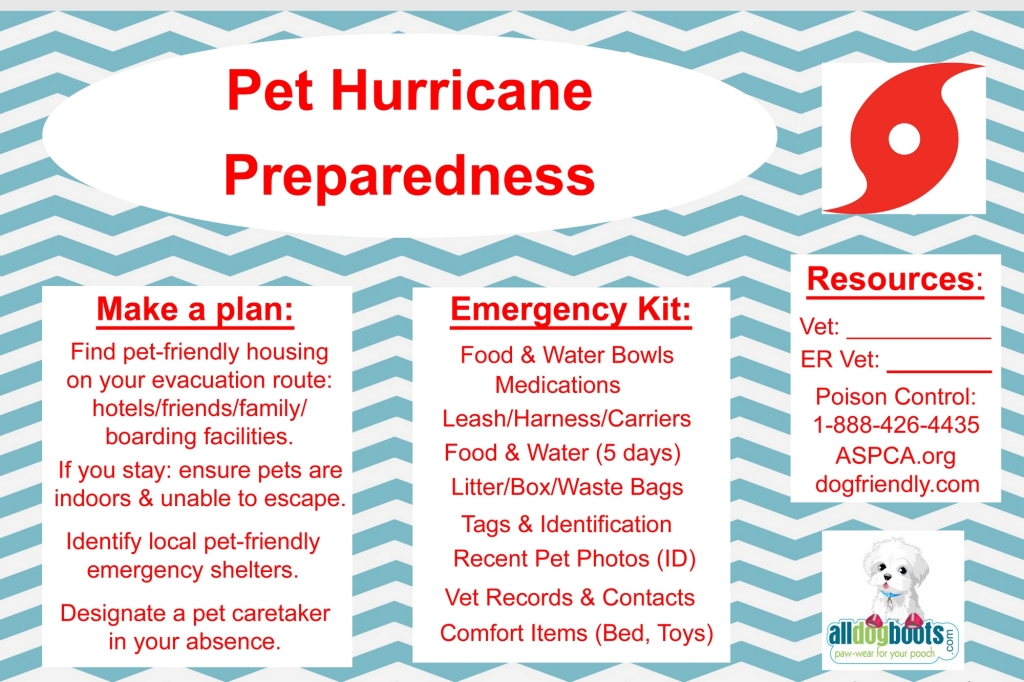A hurricane is on its way. What should you do? In the following paragraphs we are going to give you some tips on how to keep your cat or dog as safe as humanly possible. The important thing is to remember you need to prepare before a disaster strikes.

A disaster kit should be large enough to contain all the things you normally need for your pet for at least a 7-day period. It should be waterproof (a plastic container with a tight fitting lid) and labeled “disaster supplies cat or dog.”
Food: Pack the brand your pet is used to eating, both canned and dry. Smaller cans are better, as pets in a disrupted setting tend to eat less. Take along a can opener (even if the cans have lift tabs, some times they do not work.) Bowls for food and a plastic lid cover for uneaten canned food. Keep uneaten opened cans in a cooler. A spoon or two might be helpful to dish out the canned food.
Water: Enough water for at least a week. Do not keep water in a disaster kit for more than 3 months at a time and store it in a cool dark place. A water bowl along with a small bottle of bleach, to use if necessary to purify undrinkable water.
Sanitation Supplies: Kitty litter and a litter box for the cat. Take enough litter to use for at least a week along with small plastic bags to dispose of the litter when cleaning out the box. For your dog take a “pooper scooper” and plastic bags to dispose of the waste.
Cleaning supplies: Paper towels for accidents and to use for cleaning litter box, food dishes, crate or carrier.
Dish soap and some disinfectant for cleaning crates, carriers and assorted possible messes.
Pictures: Have recent photos of your pet, take several or make copies in case you need to do posters if the pet gets lost. Have a picture of you with your pet, great for identification should the pet get lost and someone finds it. This is very important.
Veterinary Information: You will need the recent records of your pet’s shots and vaccinations. You need to take a supply of any medication your pet is currently taking. Write you Vet’s name, address, and phone number on a piece of paper. Include also a note giving permission for another person besides you to get emergency treatment for your pet if you are not available. Also have your name, all available telephone numbers that can reach you, address and any other info, so if you and your pet get separated you can be found. Put all this information in a zip lock plastic bag.
Collars, tags and ID: Get your cat used to wearing a break away collar with an ID tag on it. Have your dog wearing one at all times. Get your pet a microchip and sign up with the national registry. Have several ID tags in case one gets lost. Use a harness on your cat to keep it on a leash, do not depend on the collar. More cats have been lost with collars on as they can get out of them. Have your cat practice wearing a harness at home a few hours at a time. Have several leashes (one may get lost) and keep your pet on a leash if it is not in a crate or carrier. Always know where your pet is at all times.
Miscellaneous articles: Toys, grooming supplies, dry shampoo, flea protection, extra towels, and treats.
Crate or carrier: Make certain the crate or carrier is big enough for the pet to move around comfortably and has room for food dishes and water if necessary. Crates (for dogs) take up a great deal of room and the ideal product would be a collapsible wire crate with a sturdy lock. Possible containment for a small or mid sized dog could be a collapsible exercise pen, just make certain the dog cannot dig out or crawl under it. Fasten it down with a stake driven into the ground and fastened to the pen.
First aid kit: Put together a small first aid kit that contains bandages, gauze, antiseptic wipes, some medicated cream recommended by your vet, some tweezers and scissors and a cold/hot pack.
Keep in a watertight container.
These are just a few suggestions to guide you in preparing for a disaster. The most important thing is to be prepared and ready to move when the time arrives. If you are in doubt as to whether or not you should take your pet ask yourself this question; “would I leave a young child here to cope?” If the answer is no, than take your pet.
If you are going on vacation be certain to check with the kennel or with the person who is caring for your animals to see if they have a disaster plan. This is where preplanning on your part is important. Have your disaster kit ready for them to use if necessary.
Evacuating without a pet is a heart-wrenching thing to do and please do not do it unless it is absolutely the only thing you can do. However, if it is necessary, please do your best to provide for the safety and well being of your pet.




















Leave A Comment